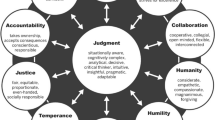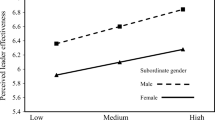Abstract
Two studies compared the effects of masculinity and femininity on rater and ratee evaluations of emergent leader behavior in mixed- and same-sex groups. Data were collected in two consensus-seeking studies using the same procedures; only the gender composition of the task groups was changed. The first study was composed of 39 female and 21 male students in 15 mixed-sex groups, and the second study included 96 female students in 22 same-sex groups. Masculinity and femininity were measured with the Bem Sex Role Inventory [L. Bem, (1974) “The Measurement of Psychology Androgyny,” Journal of Consulting and Clinical Psychology, Vol. 42, pp. 155–162]. Contrary to research and theory, masculinity was not associated with peer-rated leadership, yet femininity was correlated with two measures of self-rated leadership.
Similar content being viewed by others
References
Anderson, C. R., & Schneier, C. E. (1978). Locus of control, leader behavior and leader performance among management students. Academy of Management Journal, 21, 690–698.
Bass, B. M. (1960). Leadership, psychology, and organizational behavior. New York: Harper.
Bass, B. M. (1981). Stogdill's handbook of leadership. New York: Free Press.
Bem, S. L. (1974). The measurement of psychological androgyny. Journal of Consulting and Clinical Psychology, 42, 155–162.
Broverman, I. K., Vogel, S. R., Broverman, D., Clarkson, F., & Rosenkrantz, P. S. (1970). Sex role stereotypes and clinical judgements of mental health. Journal of Consulting and Clinical Psychology, 34, 1–7.
Butler, D., & Geis, F. L. (1990). Nonverbal affect responses to male and female leaders: Implications for leadership evaluations. Journal of Personality and Social Psychology, 58, 18–59.
Carbonell, J. L. (1984). Sex roles and leadership revisited. Journal of Applied Psychology, 69, 44–49.
Day, D. V., & Lord, R. G. (1986, August). Leadership and organizational performance: A critical review of current data and theory. Paper presented at the National Academy of Management Conference, Chicago, IL.
Deutsch, M., & Gerald, H. B. (1955). A study of normative and informational social influence upon individual judgement. Journal of Abnormal and Social Psychology, 51, 629–636.
Eagly, A. H. (1983). Gender and social influence: A social psychological analysis. American Psychologist, 38, 971–981.
Fleischer, R. A., & Chertkoff, J. M. (1986). Effects of dominance and sex on leader selection in dyadic work groups. Journal of Personality and Social Psychology, 50, 94–99.
Goktepe, J. R., & Schneier, C. E. (1989). Role of sex, gender roles, and attraction in predicting emergent leaders. Journal of Applied Psychology, 74, 165–167.
Hemphill, D. M. (1950). Leader behavior description. Columbus: Ohio State University Personnel Research Board.
Hollander, E. P., & Julian, J. W. (1969). Contemporary trends in the analysis of leadership processes. Psychological Bulletin, 71, 387–397.
LaNoue, J. B., & Curtis, R. C. (1985). Improving women's performance in mixed-sex situations by effort attributions. Psychology of Women Quarterly, 9, 337–356.
Lord, R. G., DeVader, C. L., & Alliger, G. M. (1986). A meta-analysis of the relation between personality traits and leadership perceptions: An application of validity generalization procedures. Journal of Applied Psychology, 71, 402–410.
Megargee, E. I. (1969). Influences of sex roles on the manifestation of leadership. Journal of Applied Psychology, 53, 377–382.
Powell, G. N. (1982). Sex-role identity and sex: An important distinction for research on women in management. Basic and Applied Social Psychology, 3, 67–79.
Powell, G. N., & Butterfield, D. A. (1979). The “good manager”: Masculine or androgynous? Academy of Management Journal, 22, 395–403.
Powell, G. N., & Butterfield, D. A. (1989). The “good manager”: Did androgyny fare better in the 1980s? Group & Organizational Studies, 14, 216–233.
Reed, B. G. (1983). Women leaders in small groups: Social-psychological perspectives and strategies. Social work with groups, 6, 35–42.
Schneier, C. E., & Bartol, K. M. (1980). Sex effects in emergent leadership. Journal of Applied Psychology, 65, 341–345.
Smith-Lovin, L., & Brody, C. (1989). Interruptions in group discussions: The effects of gender and group composition. American Sociological Review, 54, 424–435.
Stogdill, R. M. (1974). Handbook of leadership. New York: Free Press.
Weider-Hatfield, D. (1987). Self-reported leadership as a function of biological sex and psychological gender. Women's Studies in Communication, 10, 1–14.
Author information
Authors and Affiliations
Rights and permissions
About this article
Cite this article
Gurman, E.B., Long, K. Gender orientation and emergent leader behavior. Sex Roles 27, 391–400 (1992). https://doi.org/10.1007/BF00289947
Issue Date:
DOI: https://doi.org/10.1007/BF00289947




